Cajun Shrimp Étouffée
This post may contain affiliate links. Please check our privacy and disclosure policy.
A New Orleans classic – shrimp etouffee! We’re making etouffee from scratch, and I’m even using my own cajun seasoning blend. Serve shrimp etouffee with rice, and it is the ultimate comfort food!
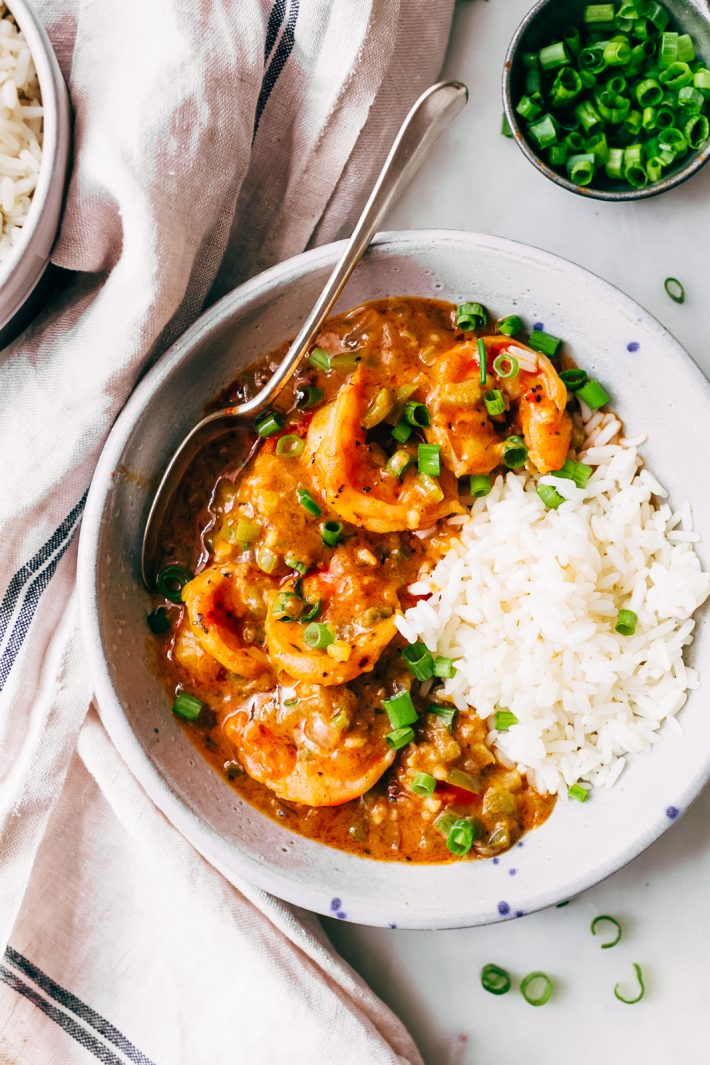
Welcome to another issue of Comfort food September!
Today we’re making another cajun classic – shrimp étouffée.
Shrimp etouffée is the kind of meal I like to throw together for Friday lunch when the weather has been extra yucky, and the hubby is working from home. It’s a treat when he’s around on a Friday, so I like to throw together a hot lunch that’s warm and comforting.
For my shrimp etouffee, I make the roux from scratch on the stove top. I know it’s a little bit of a process to do that, but it gives me plenty of time to get lost in my thoughts.
I’m telling you, it’s the kinds of meals that require mindless stirring that I love the most.
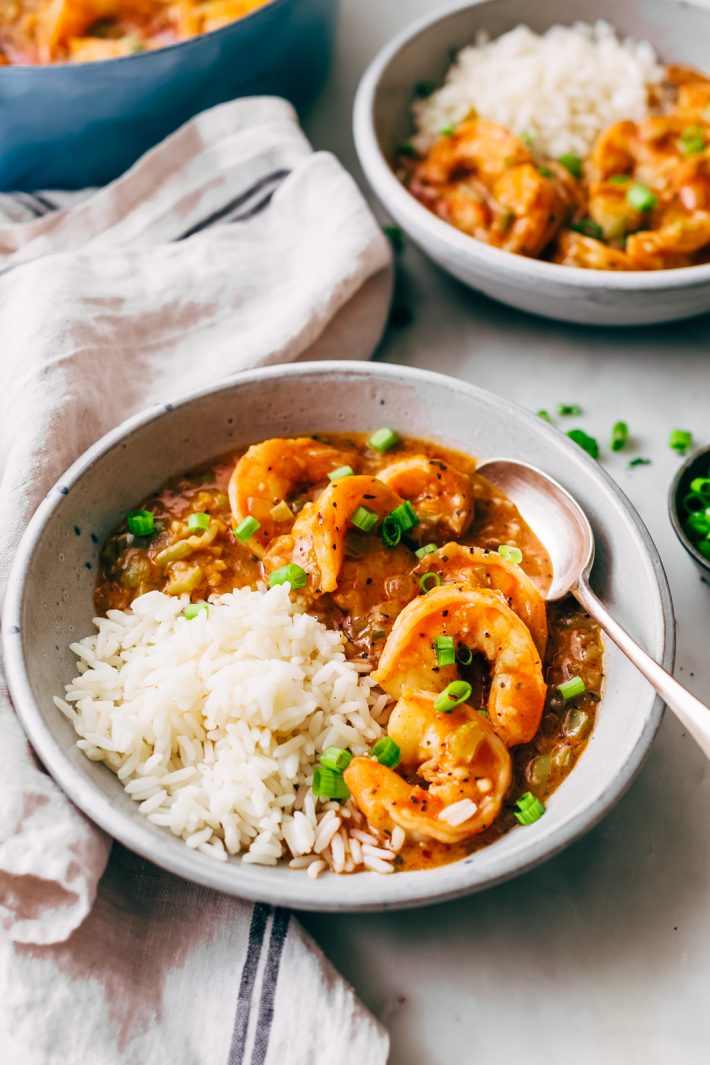
In the past, I’ve shared with you my gumbo recipe, since then, I’ve made it a million different ways. Sometimes I’ll swap the sausage for chicken, other times I’ll make a shrimp and crab gumbo and *gasp* sometimes I’ll even skip the tomatoes. No matter how many times or how many different ways I make it, the thing is, it’s always a hit with family and friends.
And today’s shrimp étouffée was a show stopper just like my gumbo recipe.
So happy to be sharing it with you, finally!
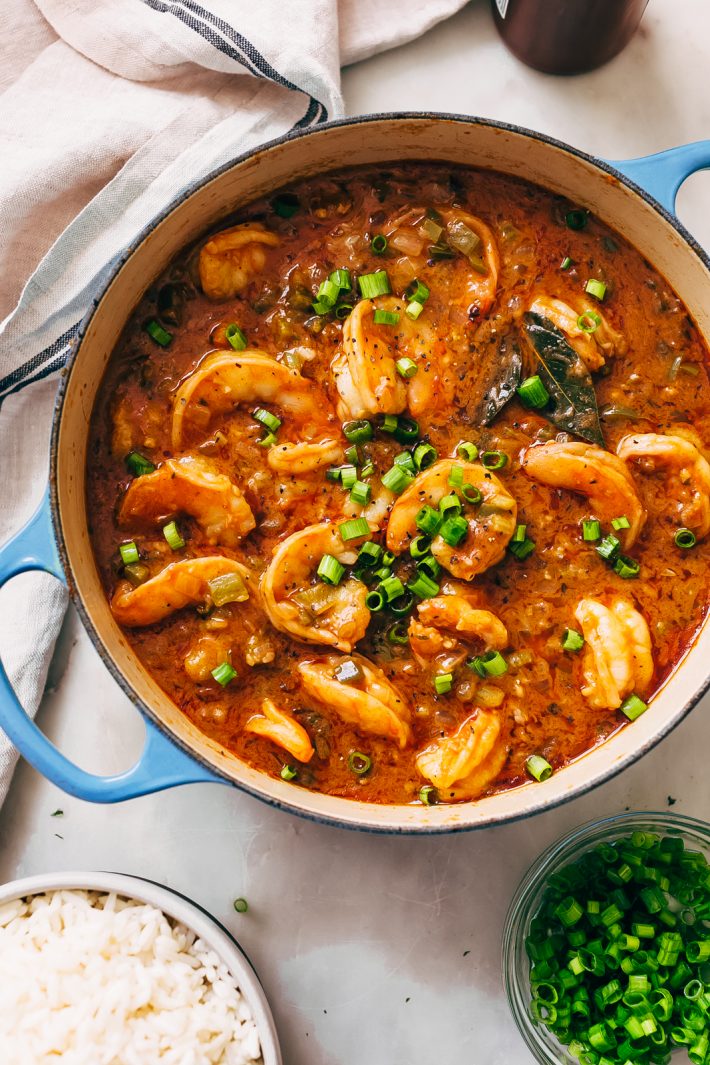
The difference between Étouffée and Gumbo:
Think of gumbo as soup. It’s got more broth and can be served in a bowl. Gumbo also usually contains more than one type of protein, chicken, shrimp, sausage, crab, and crawfish. I even leave the veggies in my gumbo a little larger because I want to find little bits of them throughout.
Étouffée is more similar to a stew. The word étouffée itself means ‘smothered.’ It’s typically a little thicker and works well when served over rice. Étouffée also usually only contains one type of protein, though you could certainly add more if you’d like!
How to make homemade shrimp stock:
Okay before I get into the how-to, do you need to make your own shrimp stock for this recipe? Absolutely not. You can certainly use store-bought seafood stock of a bottle of clam juice if you’d like.
I usually purchase shell-on shrimp, so I clean them and store the shells in a little baggy in the freezer. When I’ve got enough shells, I put on a stock pot and make stock. It’s free, and it tastes delicious in this etouffee recipe!
To make your own shrimp stock, you’ll want the shells of about 2 pounds of shrimp, 3 cups of water a few parsley springs, a few sprigs of fresh thyme, a couple of cloves of garlic, a few peppercorns, and a sprinkling of salt. Combine it all in a large stock pot and let it simmer for 30-45 minutes. Strain and the stock is good to go! If you want to make a larger batch, just double or triple everything. Leftover broth can easily be strained, cooled, and frozen.

How to make your own cajun seasoning mix:
In the past, I’ve used store bought cajun (or Creole) seasoning, but recently, I’ve started making my own. It makes it a lot easier to control the sodium this way.
All you need to do is combine:
- paprika
- onion powder
- garlic powder
- dried thyme
- dried oregano
- cayenne
- black pepper
- white pepper
Now of course, if you’ve got some cajun seasoning in your pantry already, you can certainly just use that here but for those of us that like to make their own seasonings, this tastes just as delicious and you probably already have most of these ingredients already! If you decide to use store-bought Cajun seasoning, you’ll need about one tablespoon (or more if you want it spicier!)
How to make the roux for shrimp étouffée:
Here’s the part that usually scares people but don’t worry, I’m going to walk you through this step by step.
First of all, what is a ‘roux’? A roux is the heart and soul of all étouffée and gumbo recipes. It’s a combination of oil (sometimes butter) and flour that you slowly brown until it’s a deep rich red or brown color.
To make the roux, you’ll need:
- high heat oil: such as peanut, corn, or vegetable
- all-purpose flour: unfortunately, I’m not sure if any other kind of flour can be used
- lots of stirring
To start, we’ll heat the oil in a heavy bottom pot then add the flour and whisk until all the lumps have been worked out of the flour. Then, it’s just 22-27 minutes of constant stirring.
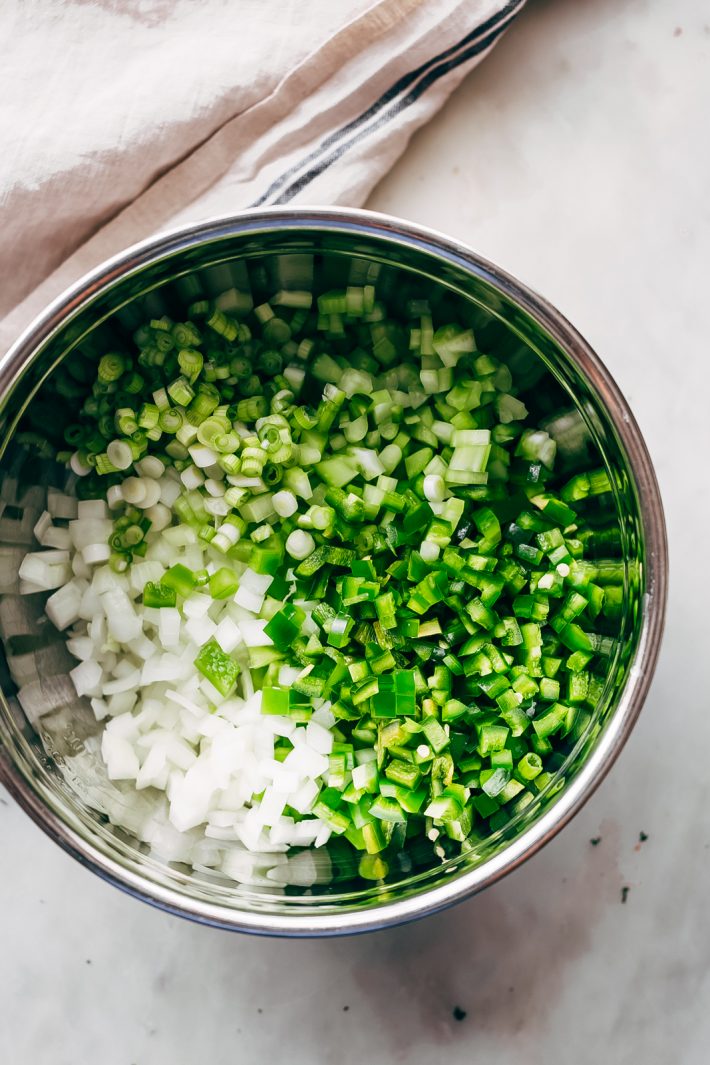
Stages of the roux:
- 0-4 minute: this is called a blond roux. It’s the kind of roux we usually make when we’re preparing a white sauce (or béchamel.) Since it only cooks for a few minutes, this type of roux is often used to make thick sauces.
- 5 minutes: here’s when the roux starts developing a little bit of color. It’ll be a cream color, almost like tahini paste. Keep in mind, the longer we cook the roux, the more it loses its thickening abilities.
- 10 minutes: Light almond butter. This type of roux often smells like buttered popcorn, or at least that what always pops into my mind at this stage of roux-making!
- 15-22 minutes: At this point, the roux should be on it’s way to the color of peanut butter. It’s nutty and medium brown in color. When I first started making a homemade roux, I would usually stop here. It still adds a bit of thickness to étouffées or gumbos while still giving you that nutty flavor. This was many, many pots of gumbo ago, now I’ve started making my roux just a tad bit darker.
- 23-27 minutes: 27 minutes seems to be my magic spot! At this stage, the roux is still deep brown but has developed a red undertone. I find it really difficult to take my roux past this point without burning.
- 28-34 minutes: This is what we call a ‘black roux.’ It’s dark and has a deep flavor and it takes some serious skills and patience to be able to get it here. It’s not something everyone likes, so I usually stop around a deep red-brown roux.
What you need to make shrimp étouffée:
- homemade roux
- holy trinity: minced onions, peppers, celery
- garlic
- shrimp stock
- homemade cajun seasoning/ bay leaves
- hot sauce
- shrimp
- butter
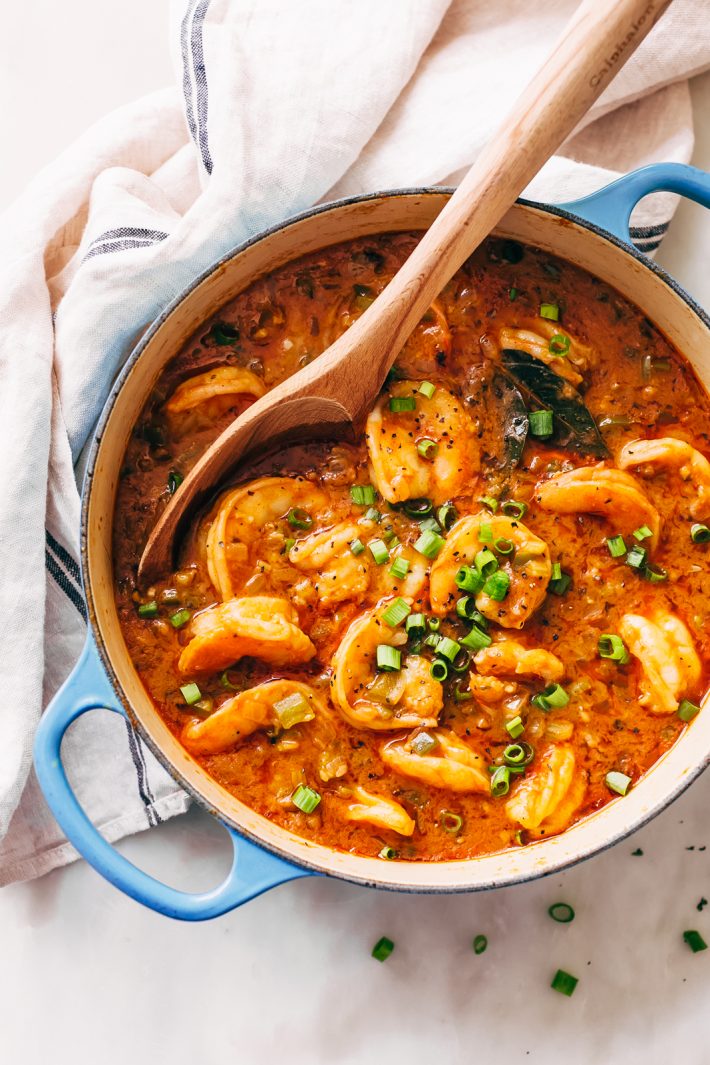
How to make shrimp étouffée:
Once you’ve made the roux, it’s pretty straightforward from there!
- Sauté the holy trinity. In Cajun or Creole cuisine the holy trinity is onions, bell peppers, and celery. I like to replace some of the bell peppers with seeded and diced jalapeños for an added kick. However, this is entirely optional. You’ll add the garlic for 30 seconds before moving on.
- Let it all simmer. Add the shrimp stock, cajun seasoning, hot sauce, bay leaves, and bring to a boil, lower the heat to low and allow the étouffée to simmer for around 15 minutes.
- Add the shrimp. Let the shrimp cook for around 3-5 minutes.
- Finish it off. Once the shrimp are cooked, turn off the heat and throw in a knob of butter.
Why do we add butter at the end to shrimp étouffée?
Remember when I mentioned that the flour loses it’s thickening abilities as we cook it down further and further into a darker roux? Well, the butter at the end is used to help thicken up the étouffée to that perfect consistency. Adding cold butter to a hot liquid and letting it melt in slowly helps thicken it. It’s what we do when we make the sauce for my garlic butter baked salmon too. The hit of butter at the end also helps add a little bit of creaminess to our étouffée.
Additional tips for making the best shrimp étouffée:
- Wide, heavy bottom pot. I usually suggest using a dutch oven (affiliate link) as this type of cooking vessel usually retains the heat better and cooks the food evenly. I’ve linked to an economical version and it’s just slightly larger than the one I’ve pictured.
- Mise en place. Literally translated it means, putting in place or preparing everything that you need for this recipe ahead of time. Don’t chop veggies while you’re making the roux – trust me – it’s not going to work out. Measure, chop, and plate everything before you start on the roux, so it’s all smooth sailing.
And there it is! This is way more words than I thought I’d be writing about shrimp etouffee but I wanted to make sure I provided as much information as I could so you feel totally comfortable making etouffee on your own too!
Add this to the weekend to do list and tell me when you make it! I want to hear alllll about it!
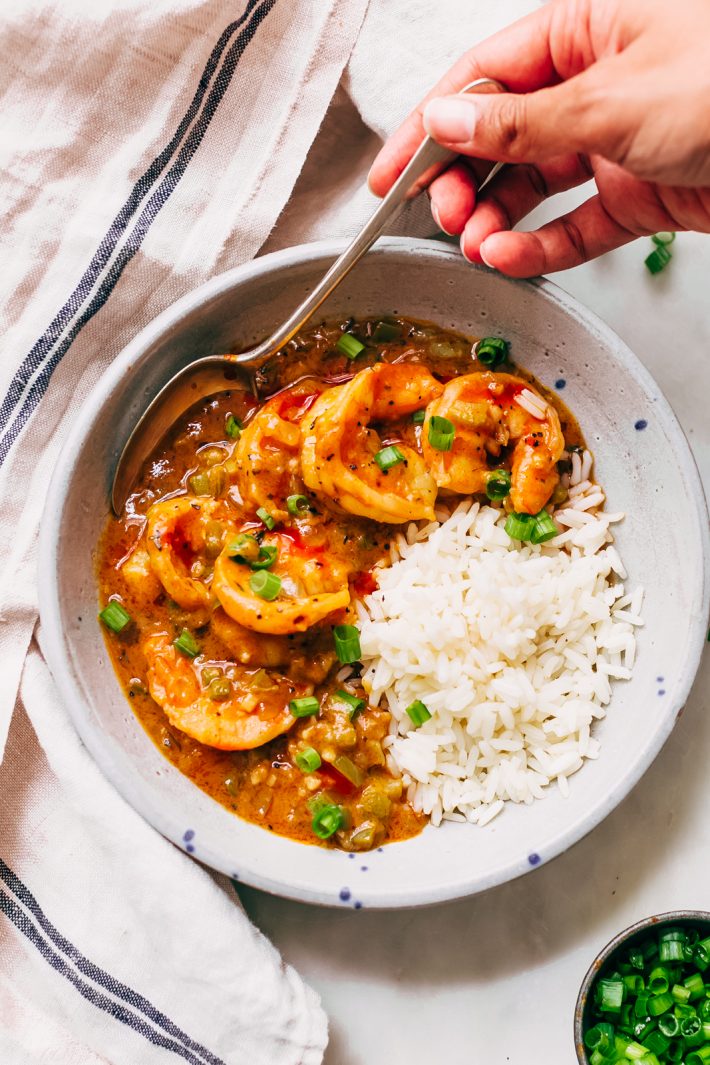
Cajun Shrimp Étouffée
A New Orleans classic - shrimp etouffee! We're making etouffee from scratch and I'm even using my own cajun seasoning blend. Serve shrimp etouffee with rice and it is the ultimate comfort food!
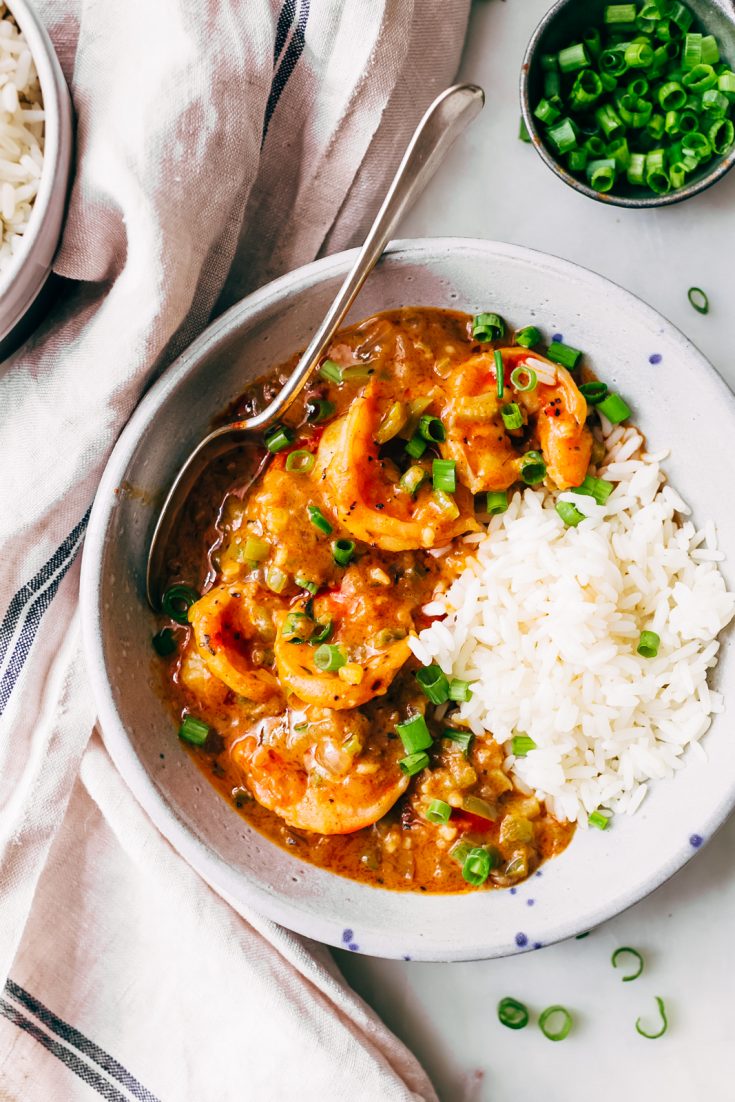
Ingredients
Cajun seasoning mix:
- ½ teaspoon EACH: dried thyme AND oregano
- ½ teaspoon EACH: garlic powder AND onion powder
- ¼ teaspoon cayenne pepper
- ¼ teaspoon EACH: black pepper AND white pepper
- 1 teaspoon sweet paprika
Étouffée:
- ½ cup EACH: high heat oil AND all-purpose flour
- 1 ¼ cup EACH: minced onions AND minced green bell peppers
- ¾ cup stalks celery, minced
- 2 jalapeños, minced (ribs and seeds removed), optional
- 6 green onions, sliced (keep greens separately)
- 12 cloves garlic, minced
- 1 ½ cups shrimp stock (or seafood stock/clam juice)
- 2 bay leaves
- 2 tablespoons EACH: hot sauce AND cold butter
- 2 pounds shrimp, peeled and deveined
- Cooked rice, for serving
Instructions
- ROUX: Heat the oil in a large dutch oven or a heavy bottom pot over medium-high heat. Whisk in the flour until combined and smooth, if the roux is cooking too quickly, lower the heat to medium. Switch to a wooden spoon and continuously stir for 20-27 minutes or until the roux darkens to just past a deep peanut butter color and is almost a little red in color. Do not let the roux burn! (if you smell it burning, you will need to throw is out, clean the pot, and start over, unfortunately, there’s just no saving burnt roux!)
- SIMMER: Once the roux reaches that deep rich brown color, stir in the onions, bell peppers, jalapeños, scallions (white part,) and celery and continue to cook, stirring as needed so the vegetables don’t stick. About 5-7 minutes or until the veggies soften. Add the garlic and continue to cook for an additional minute until the garlic is nice and fragrant. Add the shrimp stock, cajun seasoning, hot sauce, bay leaves, and bring to a boil, lower the heat to low and allow the étouffée to simmer for 15 minutes.
- FINISH: Add the shrimp, give it a stir and allow to continue to simmer for an additional 3-5 minutes or until the shrimp are opaque and cooked through. Turn off the heat, throw in the knob of butter and stir so it melts into the étouffée. Remove the bay leaves, serve warm over rice topped with green onions!
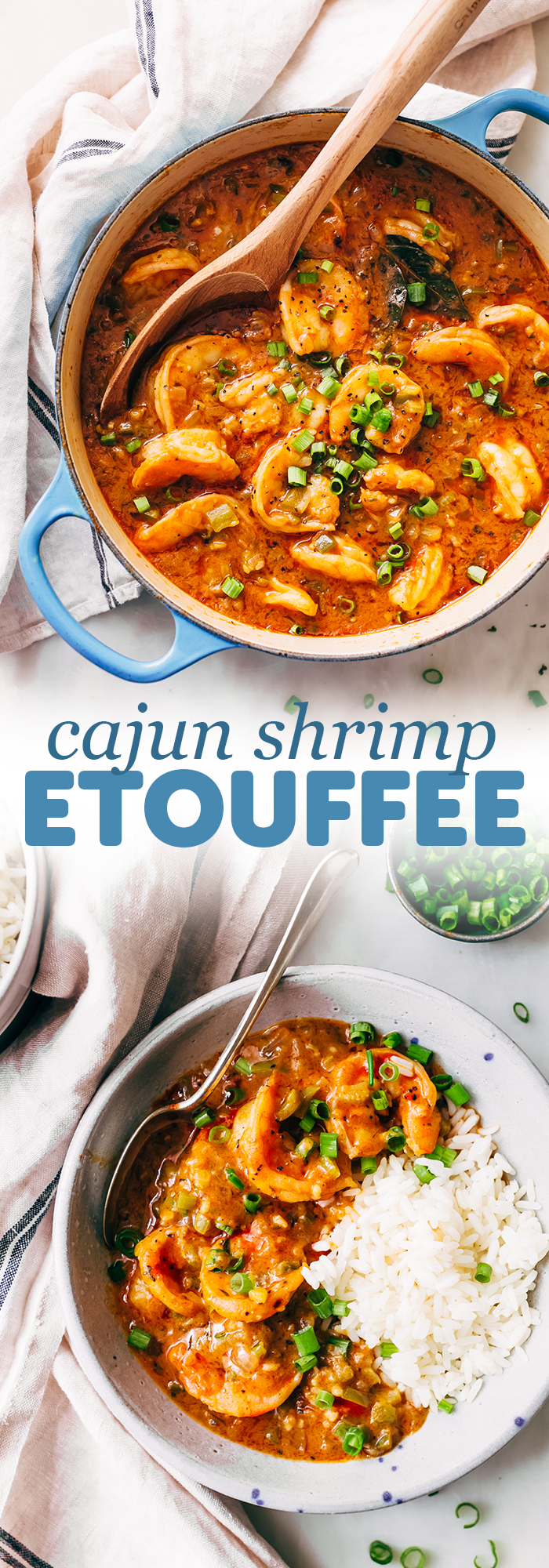
We are a participant in both the RewardStyle and Amazon Services LLC Associates Program, which are affiliate advertising programs designed to provide a means for sites to earn advertising fees by advertising and linking to amazon.com and through RewardStyle.


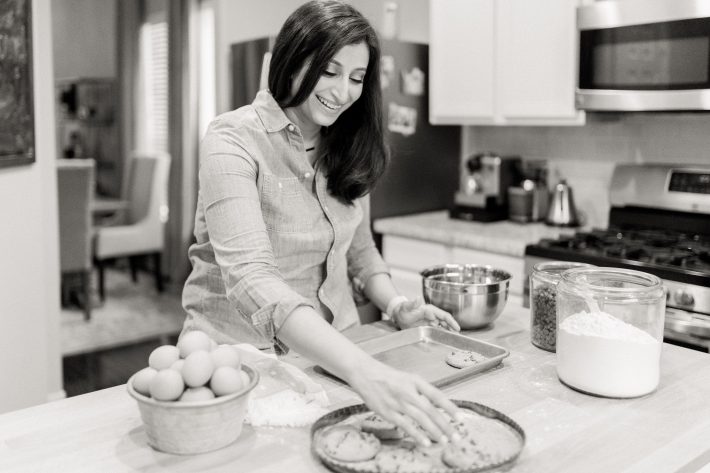
5 Comments on “Cajun Shrimp Étouffée”
I’m Cajun and have made many rouxs in my life. Many of us now just buy them already made to save time and effort. If your grocery store doesn’t have it, you can order it online. Amazon carries it. I will when I make this delicious looking recipe!
Good morning! I will be working with your recipe this evening and am considering a alternate finished product to go along side the standard one. Here on the Gulf Coast you pictured version is common, I am discovering all too often an empanada pastry shell is filled with such goodness as yours, baked until lightly browned and served as appetizers. I believe your recipe would be perfect for that idea as long as it doesn’t bleed thru. If your interested in the results, please let me know. Thanks again for a great recipe. Bobby
Nevermind, I found the breakdown of minute by minute, somehow I missed that! Great to know, I’ll give this a shot.
This looks amazing! I want to give it a shot. I’ve made a few roux’s before, I’m no pro – just want to double check, 20-27 minutes? Seems long, but again, I’m no pro! Want to be sure before I give it a shot.
Thanks!
Love learning new food cuisines I’ve never tried before! 🙂